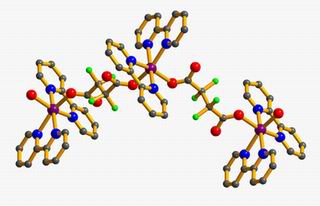1 Rosi, N. L.; Kim, J.; Eddaoudi, M.; Chen, B.; O’Keeffe, M.; Yaghi, O. M. J. Am. Chem. Soc. 2005, 127, 1504.

2 Mietrach, A.; Muesmann, T. W. T.; Christoffers, J.; Wickleder, M. S. Eur. J. Inorg. Chem. 2009, 5328.
3 Zhao, X. L.; He, H. Y.; Hu, T. P.; Dai, F. N.; Sun, D. F. Inorg. Chem. 2009, 48, 8057.

4 Chen, S. C.; Zhang, Z. H.; Chen, Q.; Gao, H. B.; Liu, Q.; He, M. Y.; Duc, M. Inorg. Chem. Commun. 2009, 12, 835.

5 Ma, Y.; Cheng, A. L.; Zhang, J. Y.; Yue, Q.; Gao, E. Q. Cryst. Growth Des. 2009, 9(2), 867.

6 Yang, J.; Yue, Q.; Li, G. D.; Cao, J. J.; Li, G. H.; Chen, J. S. Inorg. Chem. 2006, 45(7), 2857.

7 Vaidhyanathan, R.; Natarajan, S.; Rao, C. N. R. Inorg. Chem. 2002, 41(20), 5226.
8 Brusau, E. V.; Pedregosa, J. C.; Narda, G. E.; Pozzi, G.; Echeverria, G.; Punte, G. J. Coord. Chem. 2001, 54, 469.

9 Xu, X. X.; Ma, Y.; Lu, Y.; Wang, E. B.; Bai, X. L. J. Coord. Chem. 2007, 60(5), 547.
10 Zheng, Y. Q.; Lin, J. L. J. Coord. Chem. 2008, 61(21), 3420.

11 Lu, R. Q.; Chen, Y. Y.; Zhou, H.; Yuan, A. H. Acta Chim. Sinica 2010, 68(12), 1199 (in Chinese). (陆润芹, 陈莺莺, 周虎, 袁爱华, 化学学报, 2010, 68(12), 1199.)

12 Li, F. A.; Li, J. D.; Tao, R. J. Acta Chim. Sinica 2008, 66(7), 762 (in Chinese). (李付安, 李建定, 陶偌偈, 化学学报, 2008, 66(7), 762.)
13 Li, X.; Zhang, Y. B.; Zou, Y. Q. J. Mol. Struct. 2009, 919, 277.

14 Li, X.; Zhang, Y. B.; Shi, M.; Li, P. Z. Inorg. Chem. Commun. 2008, 11, 869.

15 Zhang, Y. B.; Li, X.; Li, Y. Q. J. Coord. Chem. 2009, 62(4), 583.

16 Hulvey, Z.; Ayala, E.; Furman, J. D.; Forster, P. M.; Cheetham, A. K. Cryst. Growth Des. 2009, 9(11), 4759.

17 Liu, S. Q.; Konaka, H.; Kuroda-Sowa, T.; Maekawa, M.; Suenaga, Y.; Ning, G. L.; Munakata, M. Inorg. Chim. Acta 2005, 358, 919.

18 Angaridis, P.; Cotton, F. A.; Petrukhina, M. A. Inorg. Chim. Acta 2001, 324, 318.

19 Li, X ; Qiu, X.; Zhang, Y. B. J. Mol. Struct. 2010, 964, 72.

20 Sheldrick, G. M. Acta Cryst. 1990, 67, A46.
21 Sheldrick, G. M. SHELXL97, Program for X-ray Crystal Structure Solution, University of G?ttingen, Germany, 1997.

22 Cheng, P.; Yan, S. P.; Xie, C. Z.; Zhao, B.; Chen, X. Y.; Liu, X. W.; Li, C. H.; Liao, D. Z.; Jiang, Z. H.; Wang, G. L. Eur. J. Inorg. Chem. 2004, 11, 2369.
23 Shen, W. Z.; Chen, X. Y.; Cheng, P.; Yan, S. P.; Zhai, B.; Liao, D. Z.; Jiang, Z. H. Eur. J. Inorg. Chem. 2005, 12, 2297.
24 Martin, D. P.; Supkowski, R. M.; LaDuca, R. L. Cryst. Growth Des. 2008, 8, 3518.





















